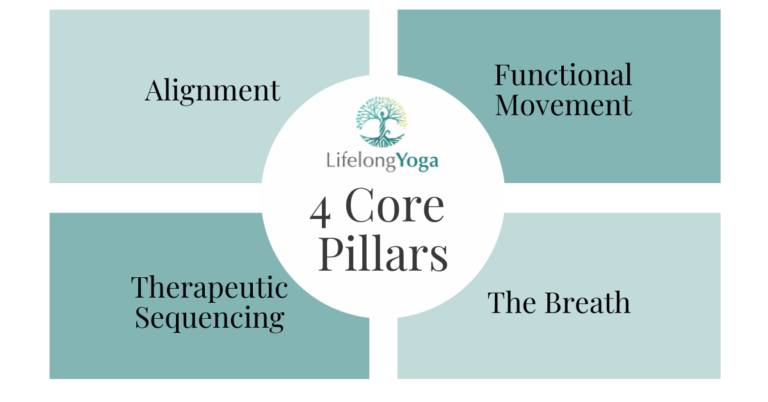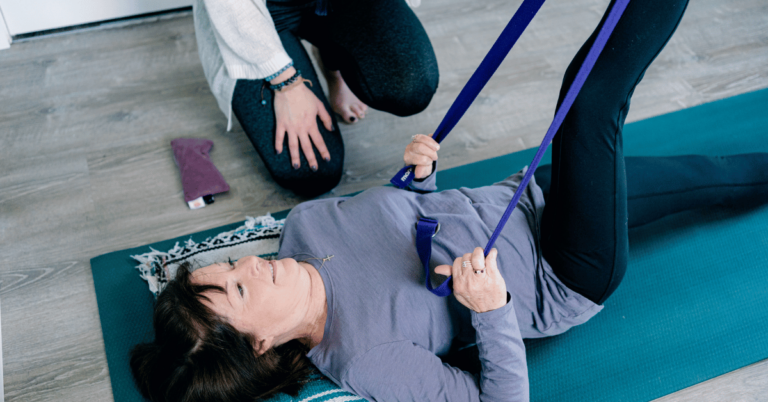Beyond Quick Fixes: How Yoga Really Helps Manage Chronic Pain

Have you ever come across headlines like “5 Yoga Poses to Cure Your Back Pain!” or “One Simple Stretch to End All Your Aches!”?
If you’re dealing with chronic pain, I bet these catchy titles have caught your eye more than once. And why wouldn’t they? The promise of a quick fix is so tempting when you’re hurting.
But here’s the thing: if managing chronic pain were as simple as doing a few yoga poses, we’d all be pain-free by now, right?
As a yoga therapist who works with many people struggling with ongoing pain, including lots of folks with arthritis and back issues, I’m here to share a different perspective. Today, let’s talk about how yoga REALLY helps with pain management – and why it’s so much more than just a set of poses or stretches.
The myth of the “magic yoga pose”
First things first: there’s no single yoga pose or quick sequence that acts like a magic wand for pain. I know, I know – not what you wanted to hear! But stick with me, because what I’m about to share is actually more empowering.
The real power of yoga in managing chronic pain lies in its holistic approach. It’s not about mastering one pose or perfecting a sequence. Instead, it’s about:
- Moving your body mindfully and regularly
- Developing a deeper awareness of your body
- Learning to breathe in ways that calm your nervous system
- Changing your relationship with pain
This approach takes time, which is why I prefer to work with my yoga therapy clients for at least 3 months. It’s not a quick fix, but a journey – a journey that can lead to lasting changes in how you experience and manage pain.
Yoga is not a quick fix, but a journey – a journey that can lead to lasting changes in how you experience and manage pain.
Mikah Horn
How yoga REALLY helps with pain
So if it’s not about specific poses, how does yoga help? Let’s break it down:
- Gentle, regular movement: Yoga encourages you to move your body in gentle, mindful ways. This can help improve flexibility, strength, and overall physical function.
- Nervous system regulation: Living with chronic pain is stressful, and that stress can actually amplify pain sensations. It’s a vicious cycle. Yoga offers powerful tools to break this cycle. Through mindful movement, breathing practices, and meditation, yoga helps activate the body’s relaxation response. This can lower overall stress levels, change how your brain processes pain signals, and, in turn, may help reduce pain intensity. One of my students with fibromyalgia found that regular yoga practice, especially focused breathing, gave her a sense of calm and control she hadn’t experienced before. It didn’t eliminate her pain, but it changed how she responded to it, making flare-ups more manageable.
- Improved body awareness: Through yoga, you’ll learn to tune in and listen to your body in new ways. This increased awareness helps you understand your pain better and respond to it more effectively.
- Mental and emotional balance: Yoga provides tools to manage the anxiety and depression that often come with chronic pain. It’s not just about the physical – it’s about supporting your whole self.
It’s worth noting that certain yoga poses can indeed be helpful for specific conditions, especially when pain is caused by physical imbalances or weaknesses in the body. For example, gentle spinal extension might help some people with lower back pain, while mobilizing the hips could benefit those with knee issues.
As a yoga therapist with extensive training in anatomy and biomechanics, I have the expertise to create sequences that target these specific issues. I can identify which poses might be most beneficial for your particular situation and how to modify them for your needs.
However, these poses are just a starting point. They work best when they’re part of a comprehensive approach that includes mindful movement, breath work, and stress management. Ideally, you want a personalized practice that not only addresses your pain points but also supports your overall well-being.
Remember, what works for one person might not work for another, which is why this individualized approach is so valuable.
What the science says about yoga and pain
Numerous studies have shown that yoga can be a powerful tool for managing various chronic pain conditions (such as sciatica, low back pain, migraines, fibromyalgia, and arthritis).
- In one study published in the Annals of Internal Medicine, researchers found that among a group of 313 individuals with chronic low back pain, participating in a weekly yoga class led to greater improvements in mobility compared to standard medical care alone.
- This meta-analysis “Yoga for Treating Headaches” revealed a statistically significant positive overall effect in favor of yoga for headache frequency, headache duration, and pain intensity.
- An 8-year clinical trial at Johns Hopkins University showed that a well-rounded yoga program for those with osteoarthritis and rheumatoid arthritis improved pain by 40%.
A simple but powerful practice: Mindful breathing
Now, you might be thinking, “This all sounds great, but what can I actually do?” Let’s start with one of my favorite tools from the yoga toolkit: our breath.
You might think that to get the most benefit, you need to breathe deeply and forcefully. But actually, when it comes to managing pain, gentler is often better. It’s about finding that sweet spot where your breath is effortless and soothing. Remember, in yoga, sometimes less really is more.

Try this simple, yet powerful breath practice:
- Find a comfortable position and place your hands on your body. Try one hand on the low belly, and the other either on your ribs or chest.
- Notice and feel your natural breath without trying to change it.
- Gradually make your breath a little slower, smoother and softer (instead of deeper).
- As you exhale, imagine tension draining from your body and mind.
- Continue for a few minutes, or as long as it feels good.
This simple practice can help calm your nervous system and give you a sense of control over sensations in your body. It’s not a cure-all, but it’s a tool you can use anytime, anywhere.
What’s next on your yoga journey?
If you’re dealing with chronic pain, I encourage you to explore yoga with an open mind and patient heart. Remember, it’s okay to start small and build gradually.
While yoga isn’t a magic cure for chronic pain, it offers a comprehensive toolkit for managing pain and improving quality of life. It’s not about finding that one perfect pose – it’s about developing a practice that supports your whole self. It requires patience, consistency, and a willingness to explore and learn.
Yoga is not about finding that one perfect pose – it’s about developing a practice that supports your whole self.
Mikah Horn
And I’m here to support you every step of the way. Depending on where you are in your journey and what kind of support you need, I offer two ways to get started:
Personalized 1:1 online yoga therapy
For those seeking individualized attention and a tailored approach to your specific pain management needs, consider working with me one-on-one. In these online sessions, we’ll create a customized yoga practice designed just for you, addressing your unique challenges and goals.
This option is perfect if you’re looking for:
- Personalized guidance on your yoga journey
- Tailored practices that address your specific pain points
- Direct feedback and adjustments to ensure safe and effective practice
Lifelong Yoga Online membership
If you’re looking for a flexible, affordable way to incorporate therapeutic yoga into your daily life, join our Lifelong Yoga Online community. For just $29/month, you’ll get access to a variety of gentle, therapeutic yoga classes that you can practice anytime, anywhere.
While not as personalized as 1:1 sessions, this is a great option to:
- Build consistency in your practice
- Explore different techniques and find what works best for you
- Connect with a community of others on a similar journey
Ready to take the next step?
If you’re not sure which option is right for you, feel free to reach out, and we can discuss the best fit for your needs and goals.
Here’s to your journey of healing and discovery through yoga!






